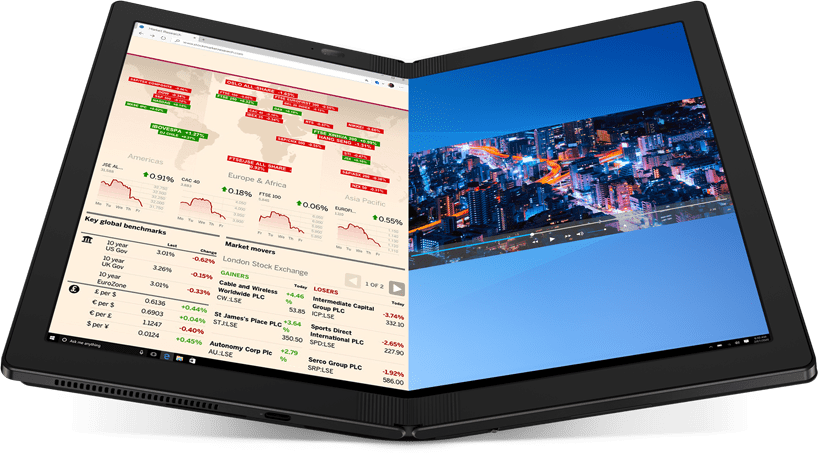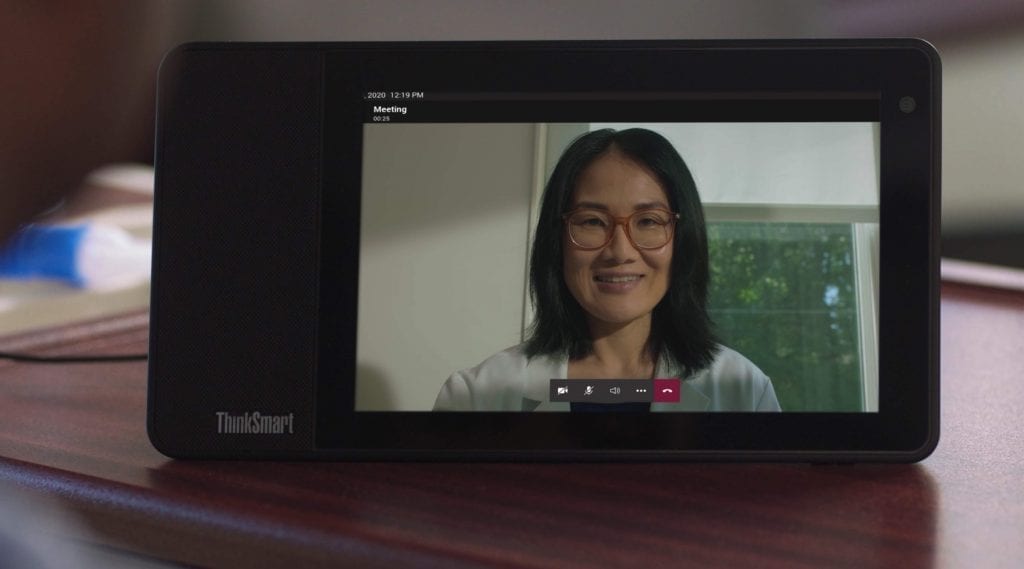The pandemic has triggered unprecedented disruptions in work, school, social connections and many industries from healthcare to entertainment. It has also accelerated digital transformation into warp speed in 2020, creating radical shifts in the new “everything-from-home” environment. We revisit some of Lenovo’s 2020 tech predictions from pre-pandemic to see how they’ve evolved, and predict COVID-19’s effect on (re)emerging technologies and the biggest trends set to take center stage into 2021 and beyond.
Prediction #1: WFH culture sets off renewed focus on smart collaboration and office set-up of the future
As a wide array of companies re-examine the functionality of the workplace and recalibrate to varying levels of a work-from-home or work-from-anywhere, we’ll start to see more traditional office workspaces become periodic collaboration hubs, while home offices become the day-to-day workplace in a new hybrid work model. The office will likely transform from many desks, conference rooms and shared amenities to a cooperative business center supporting specific project-based priorities on an ongoing basis. Configurable workstations with more nimble and portable tech will allow employees to readily adapt their surroundings as needed. These revamped spaces will also need to be equipped with enhanced smart lighting and ventilation capabilities for workers.
As a result, employers will need to equip their full workforce with the right tech tools, deployment, and IT support to maximize productivity and collaboration – for both working from home and in the workplace. According to Intel and Lenovo’s global study conducted in 2020, Empowering Your Employees With The Right Technology, only 30 percent of employees across industries report their laptops or desktop PCs work well for cross-collaboration and half responded that their computers are out of date or insufficient for work. To prioritize smart collaboration, we’ll see companies shift spending to improving IT infrastructure and basic employee needs, such as work PCs, to ensure they can be productive, regardless of location. The new employee experience will also prompt an increase in tech decisions being driven by end-users/employees alongside their IT departments, as the traditionally segmented lines of commercial and consumer tech continue to erode.

While the benefits of human workers and machine capabilities such as artificial intelligence (AI) had been established well before the pandemic – enabling us to optimize workflows, save time and communicate more effectively – the work-from-anywhere culture will prompt tech companies to develop and enhance tech that is tailored to the new behaviors of the workforce, including:
- A video-first culture will drive notable camera improvements across all device types and particularly in PCs, changing how we control and layer onto camera feeds to virtually represent ourselves to others at work.
- Improved audio technologies, including muting/unmuting, voice quality, and AI-powered natural language processing (NLP) engines that can identify speakers’ voices, better understand the nuances of human speech, note-capture and translate in real-time will make for more efficient work calls.
- Changes in collaboration technologies with the development of AI-based, multi-lens image enrichment and audio noise suppression will help with enabling more natural virtual interactions, vs solely focusing on productivity use cases. Tools that elevate asynchronous collaboration, such as digital collaboration boards and video recording, will also gain popularity.
- A renewed focus on ergonomic designs on productivity hardware including PCs, monitors and accessories will help to ease long, stationary work hours at home.
- Larger, moveable and portable displays with even higher resolution, narrower bezels, new aspect ratios and natural low blue light emissions for reduced eye strain, as well as mobile monitors for portability around the home are expected to continue to trend.
- IT support will evolve to meet the needs of a potentially permanently distributed workforce, with self-service technologies, machine learning-powered predictive support and self-healing devices gaining ground. We can also expect to see an acceleration of zero-touch provisioning, app and endpoint management offerings, managed services, modern IT solutions, and even cloud-based Software-as-a-Service (SaaS) tools that can offer IT departments the ability to diagnose issues and predict potential system failures across entire fleets of employee PCs.
- Internet of Things (IoT) solutions that help monitor safety and wellbeing in the workplace, including touchless entryways integrated into badges or smartphones, temperature sensors and AI-assisted adaptations to people’s movements in the workplace will become more important.
- A decline in printing will continue as companies and employees shift away even quicker and farther from hardcopies into cloud applications, which will require multi-cloud management solutions to monitor and secure applications and workloads from a single interface. When it comes to printing, 3D printing will eventually be left to reign supreme, where advancements will help reduce the current challenges of creating 3D models for printing.
Prediction #2: Connectivity is now essential for everyone
Last year, we dubbed 2020 the ‘Year of 5G,’ in our tech predictions. That was, of course, before the emergence of a pandemic that slowed the expected global rollout of 5G. As we reflect on 2020 and head into 2021, connectivity has stood out as more critical than ever before – for global continuity in business, school and social life.
5G will continue to transform personal computing as more PCs – joining tablets and smartphones – embrace always-on and always-connected capabilities, offering freedom from reliance on Wi-Fi alone. This is especially critical now as multiple household members stretch home Wi-Fi networks at peak hours while working and learning from home. WiFi 6 and WiFi 6E-enabled devices will also become the norm for a bump in speed even when a home Wi-Fi network is connected to multiple devices at once. As 5G-enabled device adoptions rise, we expect effective deployments of 5G infrastructure and network coverage to take time to continue to improve through 2021 and beyond.
In the consumer space, connected smart home assistants will also grow in ubiquity as prices continue to go mainstream, expanding to outside the home’s perimeter too. In the commercial sector, we will start to see Network-as-a-Service solutions that bundle IT hardware and services to better support the work-from-anywhere movement. Industrial and enterprise organizations will also build onsite 5G networks for mission-critical functions and to boost digitalization of critical infrastructure, enhance security and put in place back-up options outside of WiFi. As we move into a future where everything (all device endpoints) becomes connected, expect AI and machine learning to help our devices become more autonomous – from transportation to manufacturing.
Prediction #3: EdTech learns from the pandemic
Last year, we predicted augmented and virtual reality (AR/VR) to gain greater prevalence in providing a transporting experience for students, particularly in leveling the playing field for students who may not otherwise have access to culturally immersive, in-person field trips. Since then, COVID-19 has forced a global distance learning experiment – catapulting students, teachers, parents and school administrators into unknown territory overnight, where families and schools will need more educational technology (EdTech) to thrive in the new normal.

In 2021, the EdTech industry will double down on key learnings to leverage a renewed focus on improving personalized learning, project-based instruction, new forms of assessment, and integration of tech in teachers’ instruction delivery, virtual classroom management and collaboration. In the future, voice and computer vision can enable customized, immersive experiences reflective of each student’s goals, strengths and weaknesses. Imagine sensory interaction and spatial positioning tech that enable teachers to engage remotely with students in remote or rural areas, allowing them to interact with 3D models in real-time through sensory devices. Tech companies will be tasked with building devices and developing solutions that are affordable and accessible in order to scale.
Interestingly, distance and hybrid learning may help boost the popularity of eSports in education environments that help inspire students’ interest in STEM learning and maintain a level of social engagement while they are studying apart.
Prediction #4: Subscription culture goes commercial
Payment-based services are not a new concept within the consumer space, currently seen within subscription boxes and entertainment streaming. In 2021, the ‘everything-as-a-service’ concept will accelerate its crossover into the commercial enterprise and small-and-medium-sized business space, shifting capital expense to operational expense as companies gain access to more tech tools, IT services and security at a more affordable price. As I’ve written in Forbes, this will help with freeing up budgets and IT personnel to focus on other strategic priorities for business continuity and recovery. As the distributed workforce makes cloud IT solutions more attractive and as 5G becomes more ubiquitous, we can expect the ‘everything-as-a-service’ model to also expand and expedite IT deployments into turnkey solutions – shortening timeframes from months to days.
Prediction #5: Virtual healthcare becomes more appealing than ever
COVID-19 fueled a rapid acceleration of viable wellbeing offerings, relying on virtual healthcare to serve a dual function – help curb the spread of infection during a global pandemic while preserving patients’ healthcare access for other medical issues. Expect “virtual caregiving” to grow even more in popularity and see more innovative solutions with AI and stronger connections such as 5G built into these new experiences. Nano tech will also expand beyond 2021, focusing prominently on creating and printing cells and organs as well as customized cancer patient treatments.
Prediction #6: Home entertainment needs to get way more immersive
As we adjust to COVID-19 social norms and spend more time than ever at home, consumers will demand even more immersive home entertainment. Immersive entertainment experiences in the home will benefit from display, audio and battery life improvements that can be automatically optimized by AI and machine learning built into the devices. Gaming as a way to stay entertained and socially connected, while apart, will continue to flourish in 2021. Cloud gaming did not take off this year quite as predicted, as players continue to have high demand for high-end, high-performance gaming hardware to enjoy triple-A titles. However, with the rise of more options in cloud gaming services in 2020, it may finally be on the right path to take off in 2021 as consumers’ access to connectivity and more choice of platforms improves.
Prediction #7: New form factors navigate a new generation
2020 saw the introduction of foldable technology in PCs and smartphones that reshaped the potential of portability and productivity. In the coming years, these devices will move to the mainstream as more panel suppliers offer greater options at lower price points. Further out, as I’ve mentioned in Forbes, I think we may even see foldable tech extended to external monitors that can be folded and unfolded, rolled and unrolled, in order to expand and contract to accommodate the number of viewers watching. These displays may one day also be imbedded into our smartwatches, textiles or even toys that extend like a scroll. Enterprise-grade, AR-enabled smart glasses for more versatility in remote maintenance and training, for example, will also come to the fore.

With the Gen Z of digital natives less attached to the traditional definition of a PC form factor, dual-screen configurations, growing folding form factors, along with new kinds like on-screen keyboard inputs and voice-to-text tools that are less reliant on a physical keyboard will appeal to the next generation of tech-savvy consumers.
Prediction #8: Organizational security and consumer privacy are here to stay
Last year we predicted the rise of remote work would require organizations to adjust their security approach with proper hygiene, privilege and credential management to allow for greater flexibility. COVID-19 has sped this up significantly.
With the traditional network suddenly moving away from the corporate environment, the perimeter has now expanded to all devices connected remotely to the cloud or other work devices – where even smart home devices may add risk to corporate networks as employees log on from home. Below-the-OS attacks, where hackers dive deeper into the computing stack for vulnerabilities, is also a growing risk. More remote and cloud infrastructures in the new normal also mean companies will need to grapple with how best to keep themselves secured with integrations of partner security services. Ultimately, organizations will need to commit to a more agile, business-centric approach to security that doesn’t replace their existing security models, but rather places security within the context of the organizational strategy.
And with the increasingly blurred lines between personal and work devices, a heightened sense of privacy protection will continue to grow amongst consumers and employees working from their home environments

